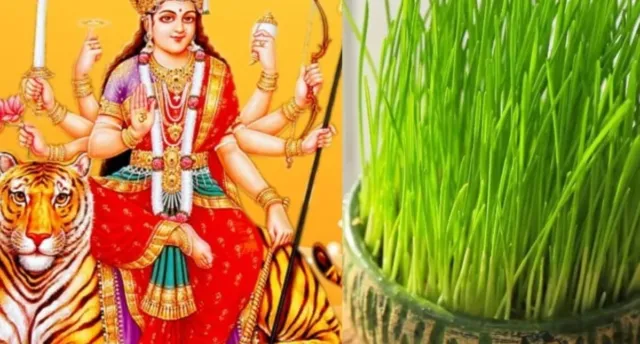
Shardiya Navratri 2025: Why is Barley Sown? Exploring the Mythological Significance
As the auspicious festival of Shardiya Navratri 2025 approaches, devotees across India are preparing to welcome Goddess Durga with immense devotion and fervor. Among the various rituals observed during these nine days, the practice of sowing barley (Jau) holds a special significance. This ancient tradition, deeply rooted in Hindu mythology and agricultural symbolism, is believed to bring prosperity, growth, and divine blessings. Let’s delve into the reasons behind this unique Navratri custom.
The Symbolism of Barley
Barley, a staple grain in Indian culture, symbolizes fertility, abundance, and the first fruit of the harvest. Sowing it during Navratri represents the sowing of seeds for a prosperous future. The germination and growth of the barley shoots are seen as an indication of the blessings of Goddess Durga and the overall well-being of the household.
Mythological Significance
The practice of sowing barley during Navratri is linked to several mythological stories. One popular belief is that barley represents Lord Brahma, the creator of the universe. By offering barley to the Goddess, devotees seek his blessings for creation and prosperity. It is also believed to be linked to Goddess Annapurna, the deity of nourishment and food. Sowing barley symbolizes seeking her blessings for abundance and a bountiful harvest.
The Ritual Process
The process of sowing barley typically begins on the first day of Navratri, also known as Ghatasthapana or Kalash Sthapana. Here’s a step-by-step guide to the ritual:
- Preparation: A clean earthen pot (e.g., a terracotta pot) is chosen. A layer of soil is placed at the bottom.
- Sowing the Seeds: Barley seeds are sprinkled evenly over the soil. Another layer of soil is added on top, gently covering the seeds.
- Watering: The soil is watered carefully, ensuring it is moist but not waterlogged.
- Placement: The pot is placed near the Kalash (a copper pot filled with water, mango leaves, and a coconut) or the idol of Goddess Durga.
- Daily Care: The barley is watered daily, and the pot is kept in a place where it receives adequate sunlight.
Interpreting the Growth
The growth of the barley shoots is carefully observed throughout the nine days of Navratri. The color and density of the shoots are believed to provide insights into the devotee’s fortune and the overall well-being of the family. Here’s a general interpretation:
- Green and Dense Shoots: This signifies prosperity, good health, and the blessings of the Goddess.
- Pale or Yellowish Shoots: This may indicate potential challenges or obstacles that need to be overcome.
- Sparse Growth: This could suggest a need for greater devotion and effort in one’s endeavors.
The Significance of the Ninth Day
On the ninth day of Navratri, known as Maha Navami, the barley shoots are typically about 5-7 inches tall. After the Navratri puja and rituals, the barley shoots are uprooted and offered to Goddess Durga. They are then distributed among family members and friends as a symbol of blessings and prosperity. Some devotees immerse the barley shoots in a water body, symbolizing the completion of the cycle of sowing and reaping.
Modern Relevance
While rooted in tradition and mythology, the practice of sowing barley during Navratri continues to hold relevance in modern times. It serves as a reminder of our connection to nature, the importance of agriculture, and the cyclical nature of life. It also fosters a sense of community and shared faith among devotees. The simple act of nurturing a plant from seed to sprout embodies the principles of patience, perseverance, and faith, all of which are valuable lessons in today’s fast-paced world.
In conclusion, the tradition of sowing barley during Shardiya Navratri is more than just a ritual; it’s a symbolic representation of hope, prosperity, and the enduring power of faith. As we prepare to celebrate Navratri 2025, let’s embrace this ancient practice and seek the blessings of Goddess Durga for a future filled with abundance and well-being.
Disclaimer: This report is auto-generated by AI.




